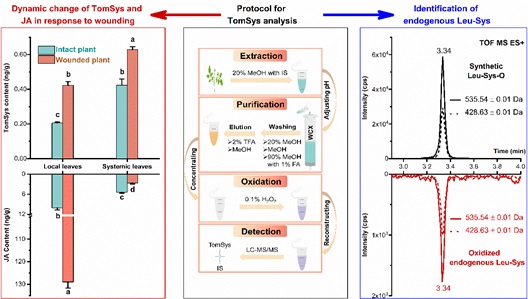In a study published in Plant Communications, CHU Jinfang’s team from the Institute of Genetics and Developmental Biology of the Chinese Academy of Sciences proposed a new advanced technology for high-accuracy measurement of tomato systemin (TomSys, a critical plant peptide hormone), providing a powerful tool for biologists to study the TomSys-mediated systemic defensive responses and further create crops with high-yield and excellent adaptability. The interesting findings obtained using this proposed new technique were also helpful to understand the maturation process and functional mechanism of TomSys during plant systemic defensive responses.
Plant hormones are naturally occurring signaling molecules in plant kingdoms. They can regulate plant development and responses to external environmental stress at very low concentrations. Due to the technical bottleneck for precise quantification of endogenous plant peptide hormone levels, the knowledge of plant small peptide hormones is still very limited compared with the classical small molecule hormones. Among plant peptide hormones, TomSys, the first discovered plant peptide hormone, arise more and more attention for decades.
TomSys can initiate systemic mobile signals to stimulate an immune response in both wounded and intact leaves. The clarification of TomSy's functional mechanism is expected to pave the way for the development of ideal strains with superior insect resistance and high yield, making it a hot area in botany. Similar to small molecule hormones, the physiological functions of TomSys should be associated with its endogenous levels. So, it is significant to unveil the spatiotemporal dynamic changes of endogenous TomSys levels during the defense process to recognize the functional mechanism of TomSys more clearly. Due to the lack of efficient TomSys analysis methods, lots of issues are unclear. How does the endogenous level of TomSys change among wounding-induced defense responses? Whether endogenously TomSys is mobile and play a role in systemic defense responses, or not? Is Leu-systemin (Leu-Sys), the key synthetic precursor of TomSys predicted by researchers, a naturally occurring biomolecule in plants? To address these issues, developing an efficient analysis method for TomSys quantification will be very helpful.
The plant hormone analysis platform (http://www.genetics.ac.cn/ztzj/js/jspt/ptjj/) has long been dedicated to developing efficient and highly sensitive analytical methods for plant hormone quantification. Until now, the methods established by the platform have been widely used in plant hormone research, which greatly contributes to the accomplishment of high-level original results in related fields in China. To solve the problem of TomSys self-oxidation, the researchers introduced a controlled oxidation strategy according to the physicochemical properties of TomSys. Meanwhile, an efficient purification and enrichment method combined with LC-MS/MS technology was elaborated to give a highly efficient analysis method for TomSys quantification. Applying the proposed novel method, endogenous TomSys can be quantified in only 100 mg tomato leaves.
On this basis, Leu-Sys, a critical precursor of TomSys predicted by scientists, was identified in tomato leaves. It was the first time to verify the natural occurrence of Leu-Sys at the endogenous level. The identification of endogenous Leu-Sys would provide direct evidence for biologists' speculation on the release of TomSys from ProSys via Leu-Sys, which will be very helpful to understand the release mechanism of TomSys. Meanwhile, the established analytical method was applied to monitor the dynamic changes of TomSys and jasmonic acid (JA) levels in response to wounding. It turns out that the accumulation of endogenous TomSys was found not only in locally wounded tomato leaves but also in systemic intact leaves. These findings are beneficial to elucidate the roles of TomSys and JA in plant systemic defense responses.
This work was financially supported by the Strategic Priority Research Program of Chinese Academy of Sciences (grant no. XDA24040202), the CAS Key Technology Talent Program (2017, Y869041), and the National Natural Science Foundation of China (grant no. 32270427, 31800303).
Graphical protocol for TomSys analysis and its application in TomSys endogenous level measurement and Leu-Sys identification (Image by IGDB)
Contacts:
Dr. CHU Jinfang and XIN Peiyong
National Centre for Plant Gene Research (Beijing), Institute of Genetics and Developmental Biology, Chinese Academy of Sciences
 Graphical protocol for TomSys analysis and its application in TomSys endogenous level measurement and Leu-Sys identification (Image by IGDB)Contacts:Dr. CHU Jinfang and XIN PeiyongNational Centre for Plant Gene Research (Beijing), Institute of Genetics and Developmental Biology, Chinese Academy of SciencesEmail: jfchu@genetics.ac.cn , pyxin@genetics.ac.cn
Graphical protocol for TomSys analysis and its application in TomSys endogenous level measurement and Leu-Sys identification (Image by IGDB)Contacts:Dr. CHU Jinfang and XIN PeiyongNational Centre for Plant Gene Research (Beijing), Institute of Genetics and Developmental Biology, Chinese Academy of SciencesEmail: jfchu@genetics.ac.cn , pyxin@genetics.ac.cn CAS
CAS
 中文
中文




.png)
